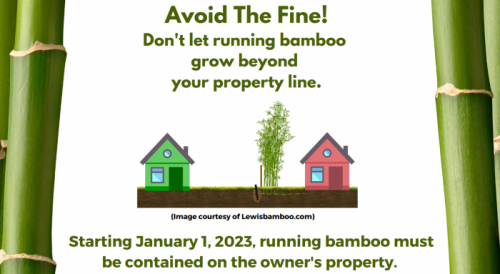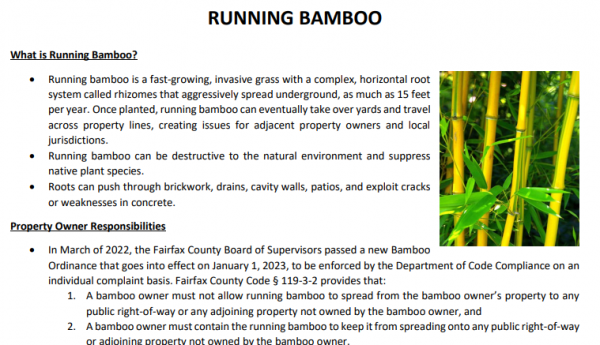Running bamboo is a fast-growing, invasive grass with a complex, horizontal root system called rhizomes that aggressively spread underground, as much as 15 feet per year.
Once planted, running bamboo can eventually take over yards and travel across property lines, creating issues for adjacent property owners and local jurisdictions.
There is no “ban” on bamboo in Fairfax County. Bamboo is not illegal to grow, sell, or cultivate. However, Fairfax County recognizes bamboo as an undesirable invasive species, and seeks to control its spread among public and private properties throughout the County. Fairfax County encourages the planting of Native Species as an alternative to invasives and other non-native plan species.
The Fairfax County Vegetation Ordinance requires property owners to contain running bamboo on their property and prevent it from spreading beyond their property line. Property owners may incur penalties if they allow bamboo to spread beyond their property.
A property owner found in violation is not required to remove or otherwise treat bamboo on neighboring properties. The owner(s) will be required to contain the bamboo on their own property, but they are not responsible for removal or treatment of areas where the bamboo has spread. Neighboring bamboo owners may be encouraged to work together to resolve these problems collectively.
Fairfax County is taking steps to managing bamboo and other invasive species throughout the County. See more information about these efforts on the County’s Invasive Species Website.
Bamboo root barriers made of polypropylene, metal, or high-density polyethylene (plastic) may be effective to contain running bamboo.
- The root barrier should be 36” in height, with approximately 30” below ground, and 6” above ground.
- The above ground portion of the barrier should go straight up toward the bamboo, so that any shoots or rhizomes hitting the barrier will be deflected toward the bamboo owner’s property and away from adjacent properties, making the rhizomes more visible to spot and cut.
Quick and early removal of bamboo can reduce the long-term impacts to surrounding trees and vegetation.
- Continued removal of new plants and sprouts will be necessary to limit new bamboo growth.
- Monitor treated areas regularly to control new seedlings or regrowth.
- Various herbicides are available to kill bamboo but should always be used in strict accordance with the label’s instructions.
- Smothering new plants and sprouts with fabrics, cardboard, or other material to completely block the sunlight may be an option depending on the coverage area.
Digging out bamboo requires heavy equipment and coordination with Virginia 811.
Cut the bamboo as low to the ground as possible and immediately apply a non-selective herbicide,in strict accordance with the label’s instructions. A brush killer containing a high concentration (20-25%) of glyphosate or triclopyr should be applied to the cut tops of the bamboo within one minute of cutting.
Subsequent herbicide applications of the leaves with a 5% concentration of glyphosate or triclopyr will be necessary to contain the bamboo growth for approximately 2-5 years. Bamboo is a hardy, fast-growing grass that has a dense rhizome network which makes it more challenging to control with single applications of herbicide.
Regular mowing (weekly or as needed depending on the season) may help reduce growth. Use the lowest deck setting on the mower. If using herbicide, wait to mow until the leaves die.
More information about control methods can be found under “Chemical and Bio Control” on the County’s Invasive Species Website.
- Cut bamboo should be in sections no longer than 6 feet for disposal.
- Residents should include all cut bamboo (roots and culms) with trash pickup - not as yard waste.
Alternately, cut culms can be dried and used as plant stakes, vine supports or materials for craft projects.
- Disturbing more than 2500 feet of land? If containment of your running bamboo requires you to disturb more than 2,500 square feet on your property, you must comply with Chapter 124.1 of the Fairfax County Code, the Erosion and Stormwater Management Ordinance. Learn more about Land Disturbance and Chapter 124.1.
- What if the bamboo is in an RPA? You must adhere to Chapter 118 of the Fairfax County Code, the Chesapeake Bay Preservation Ordinance when removing vegetation. To determine if your property is located within the RPA, please refer to the Chesapeake Bay Map on Fairfax County’s Digital Map Viewer, located at www.fairfaxcounty.gov/gisapps/DMV/default.aspx. For more information regarding the RPA, including frequently asked questions, forms and contact information, please visit www.fairfaxcounty.gov/landdevelopment/chesapeake-bay-preservation-ordinance. For additional assistance, please contact Land Development Services (LDS) Site Development and Inspection Division at 703-324-1720, TTY 711, or via email at LDSSiteQuery@fairfaxcounty.gov.
- What if the bamboo is in an easement?
- Conservation Easement: If the deed states maintenance is subject to the review and approval by the County, the owner should submit requests to FCON via email DPWESTreemail@fairfaxcounty.gov
- Stormwater Easement: Find more information on the Storm Drainage Easements webpage
- Other easement? Refer to the deed to determine responsibilities.
Master Gardeners are trained volunteer educators as part of Virginia Cooperative Extension. They work within their local communities to encourage and promote environmentally sound horticulture practices through sustainable landscape management education and training.

Help Spread the Word
Have a community or homeowner association meeting coming up? Here are resources in multiple languages to share:
Avoid the Fine Flyer

Available in:
Information Sheet

Available in:
The Department of Code Compliance (DCC) is the County Agency responsible for enforcement of the Vegetation Ordinance. You may report suspected violations to DCC online or by calling 703-324-1300 (TTY 711). Before making a report, see important information about violations and enforcement below.
Because of the nature of bamboo spread, there are challenges to determining bamboo ownership. For instance, if bamboo growth is significant and unmanaged across property lines, a DCC Investigator may find that multiple owners are in violation and may issue Notices of Violation to all owners. Once a property has bamboo, even if it has spread from a neighboring property, both properties are now considered “bamboo owners.”
DCC’s goal in enforcement is to obtain voluntary compliance, and this is particularly important in bamboo cases. To make sure our enforcement actions are legally defensible, DCC Investigators must have clearly identified the owner(s) of the bamboo and determine that the spread is significant, unabated, and that adjoining property owners are themselves taking steps to control the growth.
DCC will consider a property compliant when the bamboo owner is responsive, cooperative, and demonstrates an effort to comply with the intent of the Ordinance. We recognize the difficulties in removal and treatment programs, some of which may be yearslong efforts by property owners to control and limit the spread. For this reason, DCC will not continuously monitor a property for compliance over the long-term. As a general practice, DCC will not reopen a bamboo case for new investigation within three months from the time the original case was closed. This applies only in cases where there is no new information available from a complaint, such as the subject property being sold to a new owner, or if new bamboo is planted on the property.
Bamboo complaints can be made anonymously, but we encourage people to leave contact information. Based on the information found in the complaint, and whether the complainant provides contact information, DCC may issue an informational notice or warning letter to the property in lieu of opening an investigation.
Regardless of whether a complaint is anonymous, there may be functional limits on our ability to protect identities of neighboring property owners. This is because bamboo cases almost always require that we establish contact with neighbors to observe the spread of bamboo onto their properties.
A legal document called a Notice of Violation (NOV) may be issued to a bamboo owner who is found in violation of the Vegetation Ordinance. Importantly, a bamboo-related NOV must include the location(s) where the bamboo is growing onto (from the subject property to neighboring properties). While the neighboring property owner name(s), and complainant name(s), will not be listed in an NOV, this means that a complainant who wishes to remain anonymous may still be identified by way of the address and/or parcel identification found in the NOV.
Invasive Plant Species
Running bamboo can be destructive to the natural environment and suppress native plant species. Roots can push through brickwork, drains, cavity walls, patios, and exploit cracks or weaknesses in concrete.
Learn more about what property owners can do to help stop invasive species.

